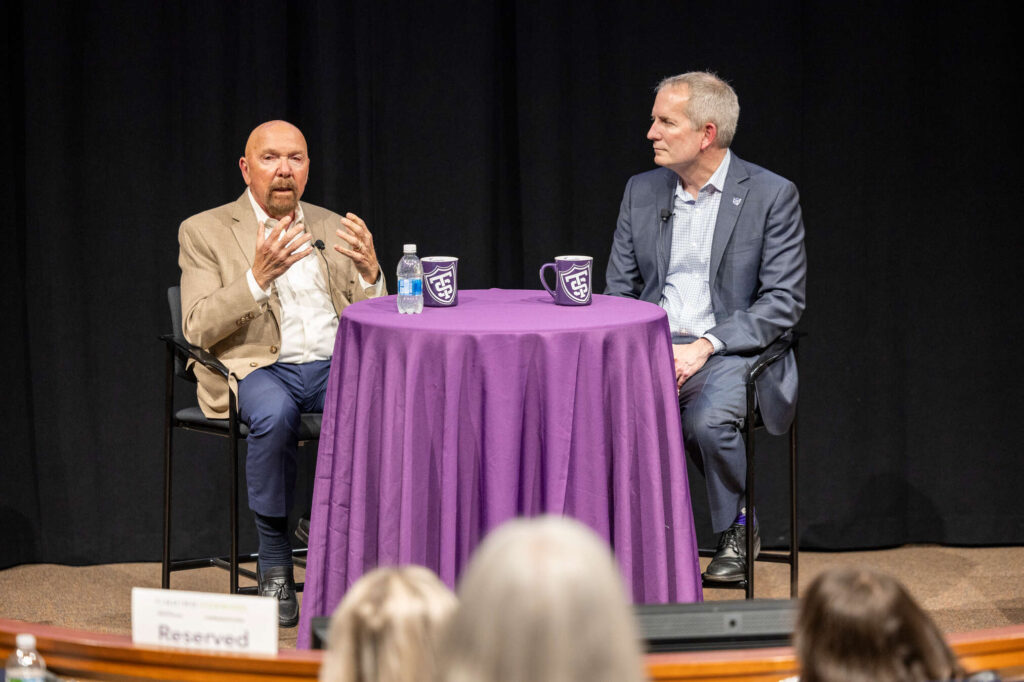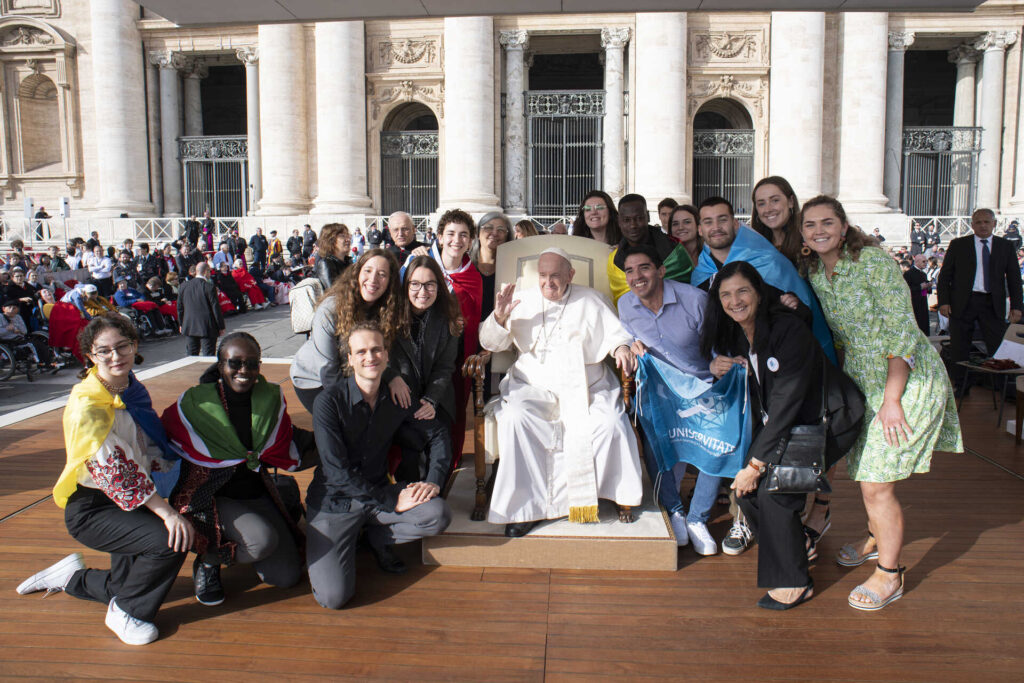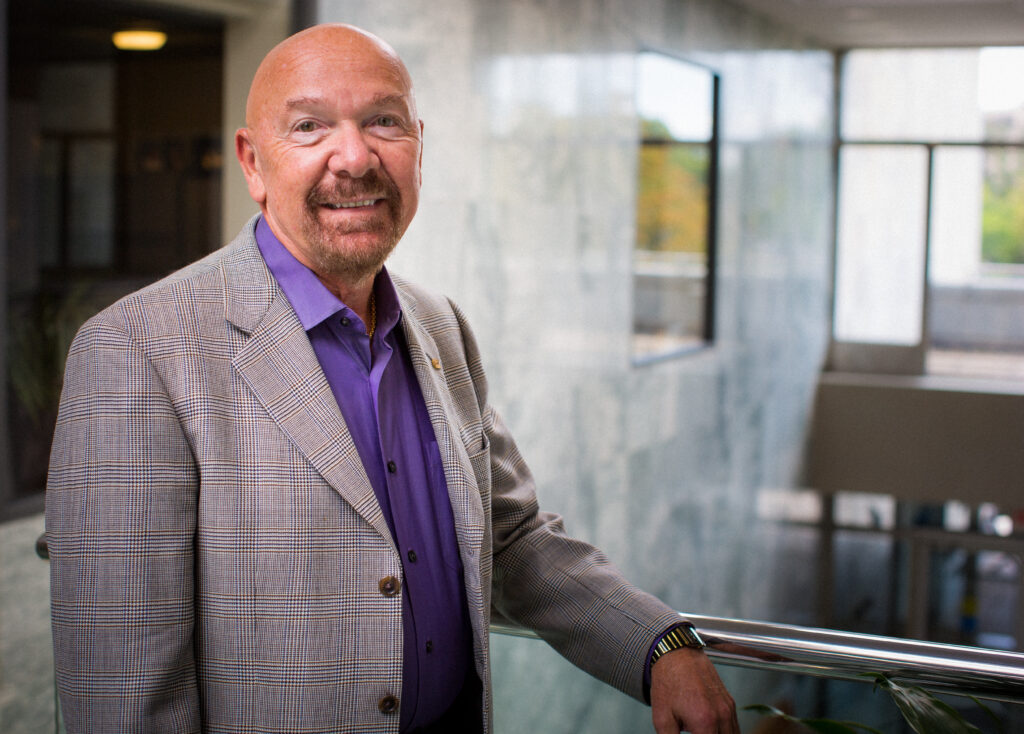Twin Cities shoppers won’t need to buy a bigger Christmas stocking this year
If that size 9 Christmas stocking hanging above your fireplace worked last year, a size 9 should do the trick this year too. According to the results of an annual study just concluded by three marketing professors at the University of St. Thomas’ Institute for Retailing Excellence, shoppers in the Twin Cities will spend about the same this year as last on holiday presents.
That’s not exactly great news for retailers, since last year’s numbers – influenced by rising gasoline prices – were down from the year before. Respondents to the fifth-annual survey said they planned to spend 1 percent more on holiday presents in 2006. Last year a more pessimistic group of shoppers predicted they would spend about 6 percent less than the year before.
According to data collected and analyzed by researchers Dr. Lorman Lundsten, Dr. Dave Brennan and Dr. John Sailors at St. Thomas’ Opus College of Business, holiday spending will total $758 per metro-area household. That is up 1 percent from last year's $750. It is also the second-lowest amount in the five years of the study, even without adjusting for inflation. In 2004, respondents said they planned to spend $796, in 2003 they said $779, and in 2002 they said $792.
The slight increase in planned spending per household this year means that total holiday spending in the 13-county Minneapolis-St. Paul area also will increase, but by a larger percentage because of a 1.2 percent growth in the number of households in the region. Based on household spending and adjusted for population growth, total spending by metro shoppers will be $935 million. That’s up 2.2 percent from last year’s $914 million and compares to $959 million in 2004, $928 million in 2003 and $924 million in 2002.
“When you take inflation into account, the actual amount of holiday spending in the Twin Cities region this year will be essentially the same as last year,” Brennan said.
The survey was conducted in October and early November. The researchers believe that concerns over energy prices had a bigger impact on shopping plans last year than this year. “The cost of gasoline was lower when this year’s survey was taken, and consumers last year were hearing about soaring heating costs for their homes,” Brennan said.
A note about planned spending and actual spending
The professors noted that their findings are based on what consumers predicted when they completed the surveys between Oct. 6 and Nov. 3. Actual spending might be higher because shoppers could spend more than they planned once they get into the stores.
Based on survey responses, Twin Cities-area shoppers are planning to be more thrifty than predictions based on three national surveys. The 1 percent increase planned this year by Twin Cities households compares to a national 5 percent increase predicted by the National Retail Federation, a 5.5 percent increase predicted by the International Council of Shopping Centers and a 7 percent increase predicted by Deloitte & Touche USA.
“In the first three years of our survey, the Minnesota findings mirrored national predictions,” Brennan noted. “For the last two years, however, respondents to our Twin Cities survey said they planned to spend less, on a percentage basis, than the numbers reported in the national surveys.”
The St. Thomas survey found that 57 percent of households expect to spend about the same this holiday season, which is up 10 percent from last year but is similar to the findings in 2002 through 2004.
More households expect to spend more (10 percent this year compared to 7 percent last year) while fewer households expect to spend less (32 percent this year compared to 46 percent last year).
“While the survey results show some positive movement, I don’t think you’d call it a rebound from last year’s downturn,” Brennan said. “While gas prices have come down in recent months, the cost of energy is still draining away money that might have been used for holiday spending.
“Other factors are contributing to the soft consumer sentiment of recent months. Credit, especially revolving credit, is more expensive, and the credit card companies are increasing minimum monthly payments. The level of home-equity loans and refinancing has dropped, so some shoppers aren’t feeling as flush as they did in recent years. And overlaying everything has been a general malaise related to the war in Iraq and pre-election economic concerns,” Brennan said.
Respondents were invited to list specific reasons why they might spend more or less this year. Some listed changes in jobs and income while others mentioned a change in family size.
Because the professors have used the same yardstick to measure consumer spending plans over the past five years, the survey findings help confirm some shopping trends and point out new ones. Among their findings:
- Retailers generally can expect a flat year in 2006; holiday spending still won’t be back to 2004 levels.
- Sales started early in the holiday shopping season last year; there’s a good chance that will happen again this year.
- Gift cards and cash continue to gain in popularity. That’s not always good news for retailers. For them, it’s a trend that means fewer actual purchases before Christmas … and more purchases in January when retailers cut prices.
- We aren’t building new malls or new downtowns, so some growth is going to “nonstore” shopping via catalogs and the Internet.
- Older shoppers like catalogs, younger shoppers like the Internet.
- The arrival of the Mall of America in the Twin Cities has prompted the regional malls to stay fresh and innovative.
- Older shoppers are less likely to drive across town to do their shopping; Brookdale and Ridgedale are popular with the older set. They are more likely to avoid the Mall of America.
- Not content to rest on past success, Rosedale keeps reinventing itself. Always a favorite mall in the last four St. Thomas surveys, Rosedale seems to be stronger than ever.
- Shoppers with deeper pockets favor the Mall of America most.
- Things are looking better for upscale retailers than for discount stores. They also look better for “multi-channel” retailers, the ones that sell products in stores, by catalogs and over the Web.
In more detail, here are results from the 2006 survey:
The things we buy
What will Twin Cities-area shoppers buy with their $758 this year? Lundsten uses a mathematical formula to analyze the rela
tive popularity of a dozen gift categories. It sheds light on the “what’s hot?” question, and allows year-to-year comparisons.

This year’s clear winner, as chosen by survey respondents, is gift certificates. Last year, gift certificates came in at No. 3.
The next two most popular gifts are books and cash. Books was No. 2 last year too, but cash was down in sixth place.
“Out of our 12 categories, books have ranked as the second or third most popular gift in all five surveys,” Lundsten noted. “They are relatively easy to purchase, especially over the Internet. Gift cards and cash are helpful when, for instance, you just don’t know what kind of music or clothing someone might like. Nationally, it’s predicted that $30 billion to $40 billion in gift cards will be given as presents this year, or more than 10 percent of U.S. holiday spending.”
Ranked No. 1 last year, clothing slid to fourth place in 2006; toys, meanwhile, placed fifth last year and this. Entertainment slipped a couple of spots, from fourth last year to sixth this year.
Seventh, eighth and ninth go to sporting goods, consumer electronics (including CDs and DVDs) and furniture and home furnishings. Sporting goods and consumer electronics each gained a spot, while furniture gained two.
Tenth, 11th and 12th go to jewelry, video games and computers. Jewelry dropped three spots while video games dropped one. Of the 12 gift categories, computers and related computer gear has ranked 12th all five years of the survey.
“It continues to appear that consumers see computers as necessary household items, rather than something you give as a gift,” Lundsten said.
Where we shop
Where do Twin Cities shoppers spend their holiday dollars? According to survey results, the big, regional malls are holding their own as the most popular place for holiday shopping. This year, respondents said they would do 47 percent of their shopping at the malls, down slightly from 50.1 percent last year.

Nonmall stores held their ground. They will receive 33.8 percent of the shopping dollars, which is virtually unchanged from last year.
This year 7.2 percent of the planned holiday budget will be spent via catalog, telephone and phone shopping, which is up from 6.8 percent last year but down from 11.8 percent in 2004.
Internet shopping will capture 12.1 percent of the holiday dollar, up from 9.5 percent last year and 7.3 percent in 2002, the first year of the survey.
“Digging into those numbers a little deeper we find that if you are over 60 you will spend 7 percent of your holiday dollars on the Internet, but if you are under 60 you will spend twice as much, or 14 percent, using the Web,” Lundsten said. “The numbers go the other way when you look at catalogs. Those over 60 spend 9 percent using catalogs and those under 60 spend 6 percent.”
Which of the regional malls are going to get the largest share of that $758 holiday budget? The researchers approached that question from two perspectives: first, which mall in the region would metro-area consumers visit at least once, and second, which mall would they shop at the most.
Those questions are similar but the results are not the same; however, for the third year in a row, Rosedale came out on top in both categories.

When asked which malls they planned to visit at least once this holiday season, Rosedale edged out the Mall of America, which also had been No. 2 in 2005 and 2004 but No. 1 in the 2003 and 2002 surveys.
This year Maplewood was third, Southdale was fourth and Ridgedale was fifth. Last year Ridgedale was third, Maplewood was fifth and Southdale was fourth.
This year’s top three malls, based on where respondents planned to shop the most, were the same as last year: Rosedale followed by Ridgedale and Maplewood. The Mall of America was fourth, up one spot from last year, while Southdale was fifth, down one spot. The nation’s oldest fully enclosed regional shopping center, Southdale is celebrating its 50th anniversary this year. It has had three owners in the last five years.
Southdale is followed by Burnsville, Northtown, Eden Prairie, downtown Minneapolis, Brookdale and downtown St. Paul. Last year the two downtowns were tied for last place; this year downtown Minneapolis was ninth on the list of 11.
By comparing the malls of choice and where the respondents live, the survey results show that shoppers favor malls closest to home. That’s not written in stone, however. Rosedale’s popularity, for example, shows that some shoppers will drive past one mall in order to visit another.

“When we looked at those who plan to spend the most, and then where they plan to do the most shopping, we found that the Mall of America was most popular among those with the biggest holiday budgets,” Sailors said. “The Mall of America was followed by the Eden Prairie and Southdale malls. As you might expect, we also found a relationship between those malls and the affluence of surrounding neighborhoods.”
And when comparing mall rankings, the researchers reminded readers that the St. Thomas survey is sent to shoppers in the 13-county metro area. It does not include those who drive or even fly here from locations outside the metro region.
About the survey
The results of the study were based on a survey that was mailed to 3,000 Twin Cities-area households in 13 counties, including two counties in western Wisconsin. The households were selected to match the demographic characteristics of Twin Cities residents, including age, income, education and geography.
The researchers received 254 completed and usable surveys. The demographic characteristics of those who returned the surveys matched the characteristics of the original sample, and in turn, the characteristics of a cross section of Twin Cities residents.
The researchers
Lundsten and Brennan are both longtime members of the Opus College of Business faculty. Sailors joined the faculty in 2005.
Lundsten is a professor of marketing and chairs the university’s Marketing Department. He holds a doctorate from the University of Michigan .
Brennan, who holds his Ph.D. from Kent State University, is a professor of marketing and co-director of the university’s Institute for Retailing Excellence.
Sailors is a specialist in consumer behavior, marketing research, and brand equity and loyalty; his doctorate is from Northwestern University.
The Institute for Retailing Excellence, part of the St. Thomas College of Business, conducts research and offers educational programs for those who work in retailing.






